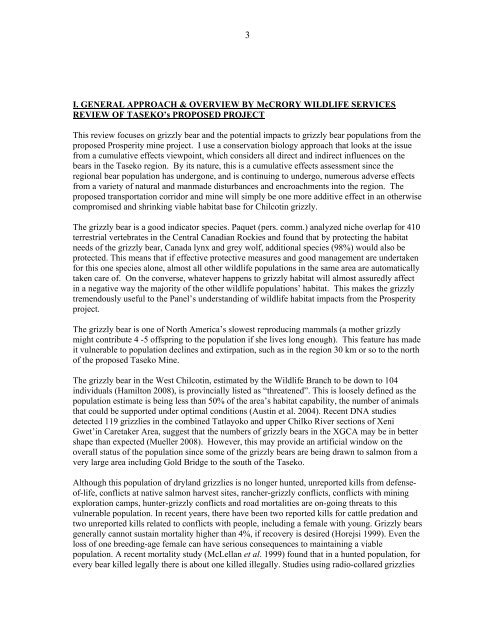From: on behalf of Panel Registry Subject: FW: TNG registration of ...
From: on behalf of Panel Registry Subject: FW: TNG registration of ...
From: on behalf of Panel Registry Subject: FW: TNG registration of ...
Create successful ePaper yourself
Turn your PDF publications into a flip-book with our unique Google optimized e-Paper software.
I. GENERAL APPROACH & OVERVIEW BY McCRORY WILDLIFE SERVICES<br />
REVIEW OF TASEKO’s PROPOSED PROJECT<br />
3<br />
This review focuses <strong>on</strong> grizzly bear and the potential impacts to grizzly bear populati<strong>on</strong>s from the<br />
proposed Prosperity mine project. I use a c<strong>on</strong>servati<strong>on</strong> biology approach that looks at the issue<br />
from a cumulative effects viewpoint, which c<strong>on</strong>siders all direct and indirect influences <strong>on</strong> the<br />
bears in the Taseko regi<strong>on</strong>. By its nature, this is a cumulative effects assessment since the<br />
regi<strong>on</strong>al bear populati<strong>on</strong> has underg<strong>on</strong>e, and is c<strong>on</strong>tinuing to undergo, numerous adverse effects<br />
from a variety <strong>of</strong> natural and manmade disturbances and encroachments into the regi<strong>on</strong>. The<br />
proposed transportati<strong>on</strong> corridor and mine will simply be <strong>on</strong>e more additive effect in an otherwise<br />
compromised and shrinking viable habitat base for Chilcotin grizzly.<br />
The grizzly bear is a good indicator species. Paquet (pers. comm.) analyzed niche overlap for 410<br />
terrestrial vertebrates in the Central Canadian Rockies and found that by protecting the habitat<br />
needs <strong>of</strong> the grizzly bear, Canada lynx and grey wolf, additi<strong>on</strong>al species (98%) would also be<br />
protected. This means that if effective protective measures and good management are undertaken<br />
for this <strong>on</strong>e species al<strong>on</strong>e, almost all other wildlife populati<strong>on</strong>s in the same area are automatically<br />
taken care <strong>of</strong>. On the c<strong>on</strong>verse, whatever happens to grizzly habitat will almost assuredly affect<br />
in a negative way the majority <strong>of</strong> the other wildlife populati<strong>on</strong>s’ habitat. This makes the grizzly<br />
tremendously useful to the <strong>Panel</strong>’s understanding <strong>of</strong> wildlife habitat impacts from the Prosperity<br />
project.<br />
The grizzly bear is <strong>on</strong>e <strong>of</strong> North America’s slowest reproducing mammals (a mother grizzly<br />
might c<strong>on</strong>tribute 4 -5 <strong>of</strong>fspring to the populati<strong>on</strong> if she lives l<strong>on</strong>g enough). This feature has made<br />
it vulnerable to populati<strong>on</strong> declines and extirpati<strong>on</strong>, such as in the regi<strong>on</strong> 30 km or so to the north<br />
<strong>of</strong> the proposed Taseko Mine.<br />
The grizzly bear in the West Chilcotin, estimated by the Wildlife Branch to be down to 104<br />
individuals (Hamilt<strong>on</strong> 2008), is provincially listed as “threatened”. This is loosely defined as the<br />
populati<strong>on</strong> estimate is being less than 50% <strong>of</strong> the area’s habitat capability, the number <strong>of</strong> animals<br />
that could be supported under optimal c<strong>on</strong>diti<strong>on</strong>s (Austin et al. 2004). Recent DNA studies<br />
detected 119 grizzlies in the combined Tatlayoko and upper Chilko River secti<strong>on</strong>s <strong>of</strong> Xeni<br />
Gwet’in Caretaker Area, suggest that the numbers <strong>of</strong> grizzly bears in the XGCA may be in better<br />
shape than expected (Mueller 2008). However, this may provide an artificial window <strong>on</strong> the<br />
overall status <strong>of</strong> the populati<strong>on</strong> since some <strong>of</strong> the grizzly bears are being drawn to salm<strong>on</strong> from a<br />
very large area including Gold Bridge to the south <strong>of</strong> the Taseko.<br />
Although this populati<strong>on</strong> <strong>of</strong> dryland grizzlies is no l<strong>on</strong>ger hunted, unreported kills from defense<strong>of</strong>-life,<br />
c<strong>on</strong>flicts at native salm<strong>on</strong> harvest sites, rancher-grizzly c<strong>on</strong>flicts, c<strong>on</strong>flicts with mining<br />
explorati<strong>on</strong> camps, hunter-grizzly c<strong>on</strong>flicts and road mortalities are <strong>on</strong>-going threats to this<br />
vulnerable populati<strong>on</strong>. In recent years, there have been two reported kills for cattle predati<strong>on</strong> and<br />
two unreported kills related to c<strong>on</strong>flicts with people, including a female with young. Grizzly bears<br />
generally cannot sustain mortality higher than 4%, if recovery is desired (Horejsi 1999). Even the<br />
loss <strong>of</strong> <strong>on</strong>e breeding-age female can have serious c<strong>on</strong>sequences to maintaining a viable<br />
populati<strong>on</strong>. A recent mortality study (McLellan et al. 1999) found that in a hunted populati<strong>on</strong>, for<br />
every bear killed legally there is about <strong>on</strong>e killed illegally. Studies using radio-collared grizzlies
















